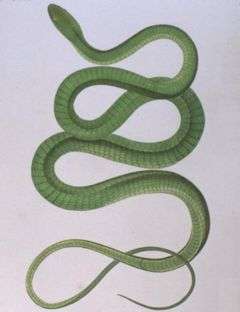Dendrelaphis punctulatus
| Dendrelaphis punctulatus | |
|---|---|
 | |
| Scientific classification | |
| Kingdom: | Animalia |
| Phylum: | Chordata |
| Class: | Reptilia |
| Order: | Squamata |
| Suborder: | Serpentes |
| Family: | Colubridae |
| Genus: | Dendrelaphis |
| Species: | D. punctulatus |
| Binomial name | |
| Dendrelaphis punctulatus (Gray, 1827) | |
| Synonyms | |
| |
The common tree snake, Dendrelaphis punctulatus, (also called green tree snake and Australian tree snake) is a slender, large-eyed, non-venomous, diurnal snake of many parts of Australia, especially in the northern and eastern coastal areas, and into Papua New Guinea.[2][3]
This common snake is harmless, readily recognised as it is an agile snake with a very slender body and tail. The body colour varies from green to olive-green to black, sometimes even blue, frequently pale yellow on the throat and belly but other pale colours have been noted, blue flecks are present on the flank. Eyes are larger than in most snakes. Found in a variety of habitats ranging from rainforest to woodland to urban areas where it preys on fish, frogs and other small animals.
It has a primitive venom apparatus and a mildly toxic venom that is not regarded as dangerous to human beings. It's tiny grooved venom-conducting fangs are positioned to the back of the upper jaw, meaning that it must partially swallow its prey in order to work the fangs into it.
Habitat
Common tree snakes live in a wide variety of habitats, including: bushland; well vegetated banks of rivers, creeks and streams; rainforest edges; eucalypt forests; heathland and areas with trees, long grass, and lush vegetation – especially near water.[4][5] When near water they often look for long grass, blending in to hide while watching for their prey to come to nearby rocks or banks to bask or play. They will also enter house gardens that have fountains or ponds surrounded by long grass or shrubs. They are active during the day, and rest at night in hollow trees, logs, foliage, or rock crevices. When resting they often are to be found in trees hence the name "tree snake".
Diet
Frogs, water skinks, and small reptiles and their eggs form a large part of the common tree snake's diet, but it will also eat small fish, mammals, geckos, and turtle hatchlings.[6][3]
Distribution
Dendrelaphis punctulatus is common in Australia's northern tropics and eastern Australia. It is also found from the Kimberley region (Western Australia) to Cape York and Torres Strait (Queensland), extending down the east coast into New South Wales, and north into Papua New Guinea.[7][3]
Breeding
The common tree snake lays eggs – 5 to 12 elongated eggs per clutch.[3]
Handling
Although common tree snakes are essentially harmless to humans, they will defend themselves by producing a horrible odour, and may bite. Sometimes when approached, the snake inflates its body and neck to make itself seem larger, a tactic sometimes used to scare prey.[8] Generally, however, tree snakes in the wild will make a quick escape when they realize someone is watching them.
